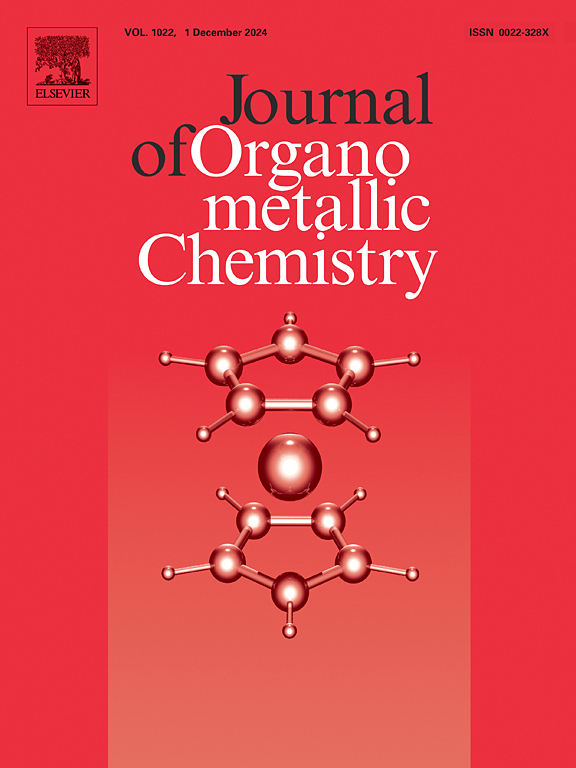Exploring the optoelectronic and photovoltaic properties of Ru-Arene complexes: DFT and TD-DFT insights into DSSC performance
IF 2.1
3区 化学
Q3 CHEMISTRY, INORGANIC & NUCLEAR
引用次数: 0
Abstract
A series of seven half-sandwich organometallic Ru-arene complexes of the form were generated and analyzed using the Density Functional Theory (DFT) and Time-Dependent Density Functional Theory (TD-DFT) approaches in both the gas phase and acetonitrile solution. These complexes were characterized by N,S-chelating ligands containing donating (-CH3,-H, and –OH) and withdrawing (-Cl, -CF3, -COOH, and –NO2) groups, and the significance of these groups in determining the properties of the molecules was evaluated. The efficiency of dye-sensitized solar cell (DSSC) technology was also examined using various photovoltaic and optoelectronic indicators, including absorption spectra (λmax, Eex, OS), HOMO-LUMO gap, molecular orbital density, the efficiency of collecting light (LHE), electron injection's driving force (ΔGinj), and regeneration's free energy (ΔGreg). Our TD-DFT findings suggest that the dyes Ru3(-COOH) and Ru4(-NO2) exhibit the largest absorption maxima and the highest LHE in the gas phase, owing to the presence of the stronger electron-withdrawing groups (-COOH and –NO2). Furthermore, our observations indicate that stronger electron-withdrawing groups enhance the photovoltaic performance of DSSCs; decreased band gap, minimized electron recombination and quicker dye regeneration were identified as crucial factors in improving performance characteristics in the gas phase. However, in the acetonitrile phase, Ru7(-OH) demonstrated a significantly increased LHE, whereas Ru3(-COOH) experienced a notable decrease. Thus, we propose that Ru3(-COOH) and Ru4 (-NO2) are more effective in converting sunlight into electricity compared to the other complexes studied in the phase gas, while Ru7(-OH) and Ru4(-NO₂) exhibit superior performance in the acetonitrile phase. These findings provide significant insight into the molecular design of metal complex sensitizers used in DSSCs highlighting the crucial role of ligand electronic effects and solvent interactions in optimizing photovoltaic performance.

探索ru -芳烃配合物的光电和光伏性质:DFT和TD-DFT对DSSC性能的影响
采用密度泛函理论(DFT)和时间相关密度泛函理论(TD-DFT)方法,在气相和乙腈溶液中制备了一系列形式为[(η6−p−cymene)RuCl(LL′)]PF6−的七种半夹心金属ru -芳烃配合物。这些配合物的特征是N、s螯合配体含有供基(-CH3、-H和-OH)和供基(-Cl、-CF3、-COOH和-NO2),并评价了这些基团在决定分子性质方面的意义。利用吸收光谱(λmax, Eex, OS)、HOMO-LUMO间隙、分子轨道密度、集光效率(LHE)、电子注入驱动力(ΔGinj)和再生自由能(ΔGreg)等多种光伏和光电指标考察了染料敏化太阳能电池(DSSC)技术的效率。我们的TD-DFT结果表明,由于存在更强的吸电子基团(-COOH和-NO2),染料Ru3(-COOH)和Ru4(-NO2)在气相中表现出最大的吸收最大值和最高的LHE。此外,我们的观察表明,更强的吸电子基团增强了DSSCs的光伏性能;减小带隙,最小化电子复合和更快的染料再生被认为是改善气相性能特征的关键因素。而在乙腈相中,Ru7(-OH)的LHE显著升高,而Ru3(-COOH)的LHE显著降低。因此,我们提出Ru3(-COOH)和Ru4(-NO2)在将太阳光转化为电能方面比在气相中研究的其他配合物更有效,而Ru7(-OH)和Ru4(-NO 2)在乙腈相中表现出更好的性能。这些发现为DSSCs中金属配合物敏化剂的分子设计提供了重要的见解,强调了配体电子效应和溶剂相互作用在优化光伏性能中的关键作用。
本文章由计算机程序翻译,如有差异,请以英文原文为准。
求助全文
约1分钟内获得全文
求助全文
来源期刊

Journal of Organometallic Chemistry
化学-无机化学与核化学
CiteScore
4.40
自引率
8.70%
发文量
221
审稿时长
36 days
期刊介绍:
The Journal of Organometallic Chemistry targets original papers dealing with theoretical aspects, structural chemistry, synthesis, physical and chemical properties (including reaction mechanisms), and practical applications of organometallic compounds.
Organometallic compounds are defined as compounds that contain metal - carbon bonds. The term metal includes all alkali and alkaline earth metals, all transition metals and the lanthanides and actinides in the Periodic Table. Metalloids including the elements in Group 13 and the heavier members of the Groups 14 - 16 are also included. The term chemistry includes syntheses, characterizations and reaction chemistry of all such compounds. Research reports based on use of organometallic complexes in bioorganometallic chemistry, medicine, material sciences, homogeneous catalysis and energy conversion are also welcome.
The scope of the journal has been enlarged to encompass important research on organometallic complexes in bioorganometallic chemistry and material sciences, and of heavier main group elements in organometallic chemistry. The journal also publishes review articles, short communications and notes.
 求助内容:
求助内容: 应助结果提醒方式:
应助结果提醒方式:


